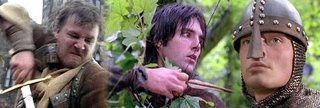

We may never know for sure whether Robin Hood ever existed outside the verses of ballads and pages of books. Not until John Major’s “History of Greater Britain” (1521), for example, is he depicted as a follower of King Richard, one of his defining characteristics in modern times. The details of their accounts vary widely, however, placing him in conflicting regions and eras.

While most contemporary scholars have failed to turn up solid clues, medieval chroniclers took for granted that a historical Robin Hood lived and breathed during the 12th or 13th century. Little John and Will Scarlet are part of this Robin’s “merry” crew-meaning, at the time, an outlaw’s gang-but Maid Marian, Friar Tuck and Alan-a-Dale would not enter the legend until later, possibly as part of the May Day rituals. Rather than a peasant, knight or fallen noble, as in later versions, the protagonist of these medieval stories is a commoner.
ROBIN HOOD THE LEGEND OF SHERWOOD KILLING SERIES
But what had inspired these nicknames: a fictional tale, an infamous bandit or an amalgam of both? The first literary references to Robin Hood appear in a series of 14th- and 15th-century ballads about a violent yeoman who lived in Sherwood Forest with his men and frequently clashed with the Sheriff of Nottingham. English legal records suggest that, as early as the 13th century, “Robehod,” “Rabunhod” and other variations had become common epithets for criminals. Later variations from times of less social upheaval dispense with the gore and cast Robin as a dispossessed aristocrat with a heart of gold and a love interest, Maid Marian.Īcademics, meanwhile, have combed the historical record for evidence of a real Robin Hood. In 14th-century England, where agrarian discontent had begun to chip away at the feudal system, he appears as an anti-establishment rebel who murders government agents and wealthy landowners. Throughout Robin’s existence, writers, performers and filmmakers have probed their imaginations for new incarnations that resonate with their respective audiences. More recently, bringing Robin to the silver screen has become a rite of passage for directors ranging from Michael Curtiz and Ridley Scott to Terry Gilliam and Mel Brooks. In the 19th century, writer-illustrators like Howard Pyle adapted the traditional tales for children, popularizing them in the United States and around the world. But how has the legend of Sherwood Forest’s merry outlaws evolved over time, and did a real Robin Hood inspire these classic tales?īeginning in the 15th century and perhaps even earlier, Christian revelers in certain parts of England celebrated May Day with plays and games involving a Robin Hood figure with near-religious significance. Over the course of 700 years, the outlaw from Nottinghamshire who robs from the rich to give to the poor has emerged as one of the most enduring folk heroes in popular culture–and one of the most versatile. The subject of ballads, books and films, Robin Hood has proven to be one of popular culture’s most enduring folk heroes.


 0 kommentar(er)
0 kommentar(er)
